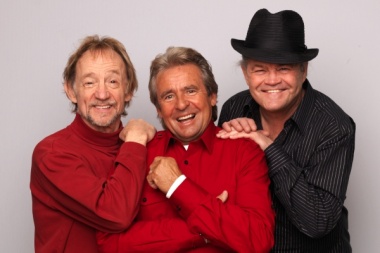Still Monkeying Around
 Yes, the appearance of The Monkees — Micky Dolenz, Davy Jones and Peter Tork — at the Aronoff Center for the Arts on Saturday night could be considered merely an oldies/nostalgia show. But it’s much more.
Yes, the appearance of The Monkees — Micky Dolenz, Davy Jones and Peter Tork — at the Aronoff Center for the Arts on Saturday night could be considered merely an oldies/nostalgia show. But it’s much more.
The group, augmented by a veritable orchestra of musicians, will play the hit songs first recorded when their stylish, Beatles-influenced 1966-1968 television show was the rage — “I’m a Believer,” “Last Train to Clarksville,” “Daydream Believer,” “Words,” “Pleasant Valley Sunday,” “Valleri” and more were smashes. (Mike Nesmith, the group’s fourth member, only rarely participates in these intermittent Monkees reunions and is not part of this — although he has a standing invitation.)
“We’re going through the whole Monkee catalogue,” says Micky Dolenz, the group’s drummer and dynamic co-lead singer, during a telephone interview. “As we started to grow, many of the songs had horns and strings and percussion and much more of a big-band sound. So we’re bringing a bunch of friends — it’s more like Mad Dogs and Monkees.” (That last reference is a play on Mad Dogs and Englishmen, the name of a famous-at-the-time 1970 touring troupe that backed British Rock singer Joe Cocker as he became a major star.)
The Aronoff show is a chance to look back and appreciate the cultural relevancy — even avant-gardism — of The Monkees in their heyday. For instance, there was the 1968 movie Head, which came out after the series had ended and was so psychedelically surreal and narratively irreverent that it freaked out those who saw its initial theatrical release.
Yet the reputation of the film and its soundtrack album — featuring Gerry Goffin/Carole King’s lovely, dreamy “Porpoise Song” — keeps growing. Last fall, Rhino Records released a boxed set featuring the original album, bonus material and outtakes and rarities. And this year the prestigious Criterion Collection, which releases films of artistic merit on DVD/Blu-ray, featured Head as part of its seven-film America Lost and Found: The BBS Story set — along with Easy Rider, Five Easy Pieces and The Last Picture Show.
The BBS production company — which stands for Bob Rafelson, Burt Schneider and Steve Blauner — used revenue from Rafelson and Schneider’s creation of The Monkees’ TV show to start the New Hollywood film revolution of the late 1960s and early 1970s. Rafelson directed Head, BBS’s first film, and co-wrote its script with Jack Nicholson, with much creative contribution from The Monkees. After that, BBS produced Easy Rider, which contained Nicholson’s breakthrough acting role, and Rafelson’s classic Five Easy Pieces, which featured Nicholson as its star.
“It’s a real little cult favorite,” Dolenz says of Head. “We do the whole album in our show with video from the movie. It’s a great part of the show. I’m very proud of it. I’m proud of the movie. I’m not sure what it was about, myself, but it sure looked good.
“We didn’t want to do a 90-minute version of our television show. And we met Jack Nicholson and all agreed he’d write the film, and we had a lot of input. At the time, it was strange and the fans didn’t get it. The hip-eoisie didn’t get it, either. But the proof is in the pudding — it’s starting to get its due.”
There were other ways, too, that The Monkees were avant garde. After hearing the new, revolutionary Moog synthesizer, Dolenz bought one — the first on the West Coast, he believes. He used it on “Daily Nightly,” a song on The Monkees’ 1967 album Pisces, Aquarius, Capricorn and Jones Ltd.
A drummer playing Moog?
“I was cast as the drummer and had to learn the instrument for show,” says Dolenz, who was a child actor featured in the TV series Circus Boy. “My instrument of choice was the guitar, actually classical guitar and Spanish. Then I morphed from that into Folk music and then Rock & Roll. My audition piece for The Monkees was ‘Johnny B. Goode’ on guitar.”
Dolenz eventually sold his Moog to Bobby Sherman, a late-1960s teen idol who starred in the TV series Here Come the Brides and sang on several hit records.
“He had a studio, and also was a collector of stuff,” Dolenz explains. “He helped me build my first studio. It’s a good question — I wonder what he did with it? I should call him up and ask.”
 Follow us
Follow us Join us
Join us


